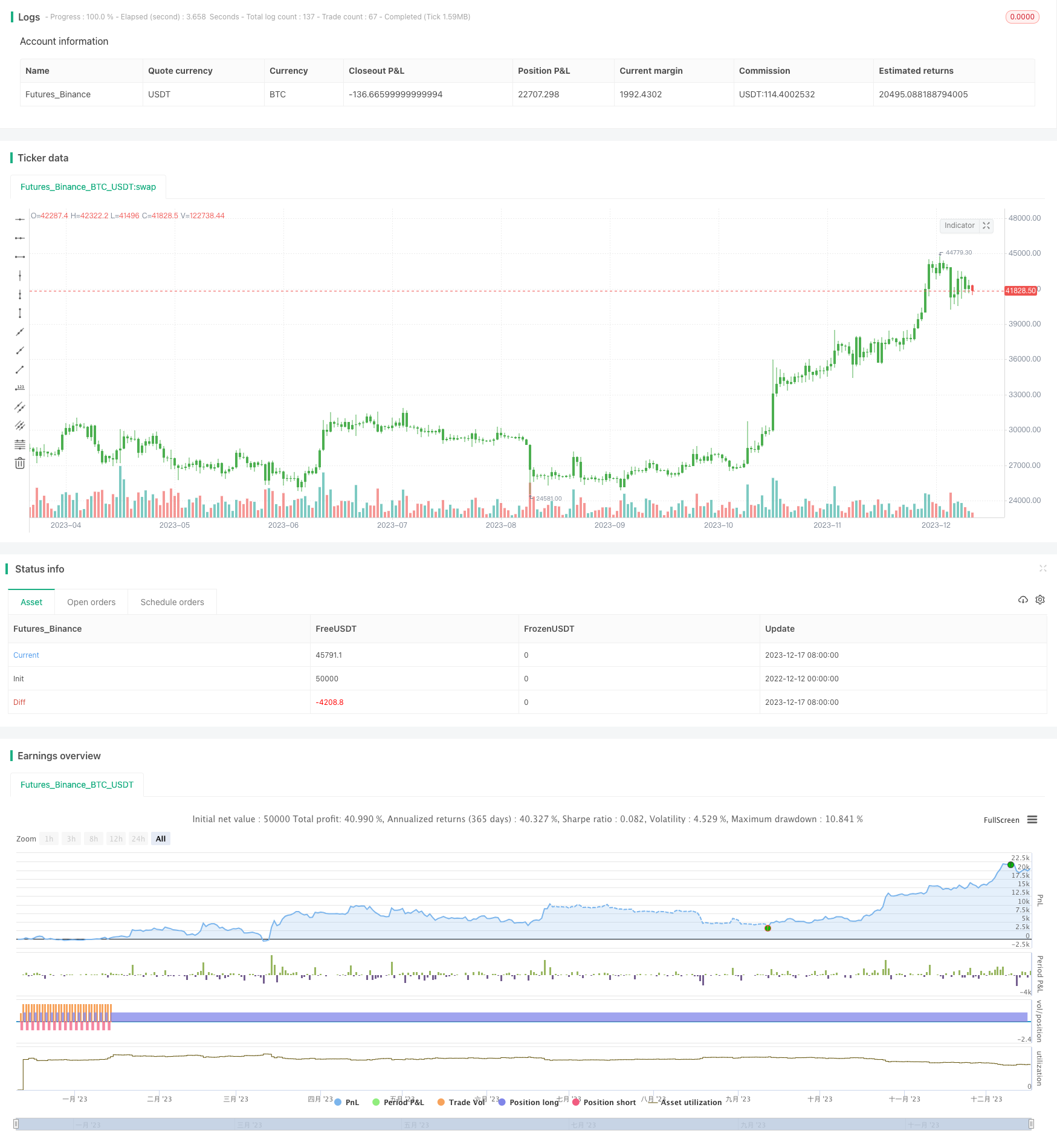
概述
该策略是一个多因子模型驱动的自适应趋势追踪策略。它整合了RSI、MACD、Stochastics等多个指标,构建多因子模型判断趋势方向。同时,它具有自适应止损机制,可以根据ATR动态调整止损价格,实现风险控制。
原理
该策略运用多个指标构建判断趋势的模型。首先,它结合RSI、MACD判断趋势方向;然后,结合Stochastics判断是否超买超卖,过滤掉部分信号。在进入订单后,它利用ATR计算风险参数,实现自适应止损。
具体来说,当RSI高于52并且MACD金叉时产生买入信号;当RSI低于48并且MACD死叉时产生卖出信号。为了过滤假信号,它还会检测Stochastics是否超买超卖。在止损方面,它根据ATR计算参数,实现自适应止损,可以有效控制单笔止损风险。
优势
该策略最大的优势在于风险控制能力强。通过多因子模型判断趋势方向,可以过滤掉部分噪音,提高信号质量。同时,自适应止损机制可以根据市场波动程度调整止损幅度,有效控制单笔损失。
此外,该策略参数设置合理,回测效果较好。不同周期资产可以通过调整参数实现最佳化。它可以通过参数优化适应更多市场环境。
风险
该策略主要风险在于多因子模型构建的质量。如果模型构建不当,不能有效判别趋势,则会产生大量错误信号。此外,止损策略本身就存在被套利的风险。
为降低这些风险,可以从调整模型权重、优化参数设置、组合其他止损策略等方面进行改进。当出现异常市场时,手工干预也是必要的。
优化方向
该策略可以从以下几个方面进行优化:
调整多因子模型中的指标权重,找到最优权重组合
测试更多指标,如CCI、波动率等,丰富多因子模型
优化参数设置,适应更多品种和周期
尝试不同的止损策略,寻找最佳组合
增加模型训练和策略评估模块,实现机器学习驱动
总结
该策略整合多因子模型和自适应止损机制,实现了趋势判断和风险控制的有机结合。它回测效果良好,具有扩展性。通过持续优化,它可以成为一个值得长期持有的定量策略。
/*backtest
start: 2022-12-12 00:00:00
end: 2023-12-18 00:00:00
period: 1d
basePeriod: 1h
exchanges: [{"eid":"Futures_Binance","currency":"BTC_USDT"}]
*/
//@version=2
strategy(title="TradersAI_UTBot", overlay = true)
// CREDITS to @HPotter for the orginal code.
// CREDITS to @Yo_adriiiiaan for recently publishing the UT Bot study based on the original code -
// I just added some simple code to turn it into a strategy so that you all can backtest it to see the results for yourself!
// Use this strategy on your favorite instrumnet and timeframe, with your favorite settings
// While @Yo_adriiiiaan mentions it works best on a 4-hour timeframe or above,
// I am happy to share here this working on a 15-minute chart on e-mini S&P 500 Index (using the KeyValue setting at 10)
// I am sure different people would discover different settings that work best for their preferred instrumnet/timeframe etc.
// Play with it and enjoy! And, don't forget to share any positive results you might get! Good luck with your trading!
SOURCE = input(hlc3)
RSILENGTH = input(14, title = "RSI LENGTH")
RSICENTERLINE = input(52, title = "RSI CENTER LINE")
MACDFASTLENGTH = input(7, title = "MACD FAST LENGTH")
MACDSLOWLENGTH = input(12, title = "MACD SLOW LENGTH")
MACDSIGNALSMOOTHING = input(12, title = "MACD SIGNAL SMOOTHING")
a = input(10, title = "Key Vaule. 'This changes the sensitivity'")
SmoothK = input(3)
SmoothD = input(3)
LengthRSI = input(14)
LengthStoch = input(14)
RSISource = input(close)
c = input(10, title="ATR Period")
xATR = atr(c)
nLoss = a * xATR
xATRTrailingStop = iff(close > nz(xATRTrailingStop[1], 0) and close[1] > nz(xATRTrailingStop[1], 0), max(nz(xATRTrailingStop[1]), close - nLoss),
iff(close < nz(xATRTrailingStop[1], 0) and close[1] < nz(xATRTrailingStop[1], 0), min(nz(xATRTrailingStop[1]), close + nLoss),
iff(close > nz(xATRTrailingStop[1], 0), close - nLoss, close + nLoss)))
pos = iff(close[1] < nz(xATRTrailingStop[1], 0) and close > nz(xATRTrailingStop[1], 0), 1,
iff(close[1] > nz(xATRTrailingStop[1], 0) and close < nz(xATRTrailingStop[1], 0), -1, nz(pos[1], 0)))
color = pos == -1 ? red: pos == 1 ? green : blue
ema= ema(close,1)
above = crossover(ema,xATRTrailingStop )
below = crossover(xATRTrailingStop,ema)
buy = close > xATRTrailingStop and above
sell = close < xATRTrailingStop and below
barbuy = close > xATRTrailingStop
barsell = close < xATRTrailingStop
plotshape(buy, title = "Buy", text = 'Buy', style = shape.labelup, location = location.belowbar, color= green,textcolor = white, transp = 0, size = size.tiny)
plotshape(sell, title = "Sell", text = 'Sell', style = shape.labeldown, location = location.abovebar, color= red,textcolor = white, transp = 0, size = size.tiny)
barcolor(barbuy? green:na)
barcolor(barsell? red:na)
alertcondition(buy, title='Buy', message='Buy')
alertcondition(sell, title='Sell', message='Sell')
if(buy)
strategy.entry("UTBotBuy",strategy.long)
if(sell)
strategy.entry("UTBotSell",strategy.short)